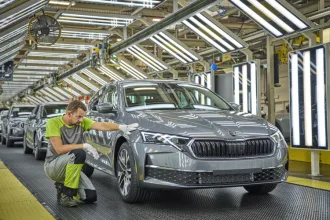- More distinctive: The model family now includes three variants The Audi S e-tron GT, the Audi RS e-tron GT, and the Audi RS e-tron GT performance
- More powerful: Significant advances in range, performance, and charging
- More variable: Newly developed suspension makes for an ideal balance between driving comfort and dynamics
The Audi e-tron GT quattro has been the electric and sporty top model in Audi’s product portfolio since its premiere in 2021. The four-door Gran Turismo combines evocative design with a powerful drive system and dynamic handling. The new versions significantly improve the sporty vehicle’s range, performance, charging, and handling. With the RS e-tron GT performance, Audi is debuting its first fully electric RS performance model. The new models in the Audi e-tron GT family are available to order now.
‘With the e-tron GT models, we are setting new standards in performance. The increased charging power and electric all-wheel drive ensure improved long-distance capability and considerably more performance. The newly developed chassis offers an unprecedented range between driving comfort, ride comfort, and driving dynamics,’ says Gernot Döllner, Chairman of the Board of Management of AUDI AG.
The new variants of the e-tron GT series combine a progressive design with innovative technology, each having a distinctive look. For example, the new Audi S e-tron GT stands for elegant sportiness. Its front end is homogeneous and expressive at the same time. A black mask encircles the fully closed, inverted Singleframe, which reflects the specific design language of the e-tron models. Embossed structures lend the grille a precise three‑dimensionality. A strip of body‑color paint above the Singleframe gives the Gran Turismo an even sportier and visually deeper look. The air curtains, which ensure optimized airflow around the front wheel in the front apron, are more strongly shaped. An elegantly designed aerodynamic diffuser with vertical fins dominates the rear end. A body‑color inlay above the rear diffuser adds even more visual texture and acts as a link between the diffuser and rear bumper.
The new Audi RS e-tron GT is now sportier as well. Its front end alone features a much more radical look. The inverted Singleframe comes in the RS‑typical 3D honeycomb structure. The apron framing the black mask visually opens the RS e-tron downwards. The vehicle appears lower, seeming to hug the street in combination with the functional L‑shaped blades. The rear end of the RS e-tron GT borrows elements from motorsports. The streamlined diffuser echoes the theme of three-dimensional efficiency elements in the front, such as the L‑shaped blades, in the rear of the vehicle. The blades come as standard in body color for a sporty look. Another detail from racing is a vertical, red reflector sitting between the aero channels.
The Audi RS e-tron GT performance is the first fully electric RS performance model. It features unique design elements and stands out from the RS e-tron GT with an optional matte, darkened carbon roof in combination with optional carbon camouflage elements. These elements are a first from Audi and are intended exclusively for the RS performance. The carbon camouflage is used in the embossed bumper structures, the door trim, parts of the diffuser, and the side mirrors.
The new corporate identity (CI) also contributes to the exterior upgrade for the e-tron GT family. The four rings now come in a premium-quality, two-dimensional design positioned between the radiator grille and the front apron. The range of colors features nine exterior finishes. In addition to solid Arkona White, it includes the metallic or pearl effect colors Ascari Blue, Daytona Gray, Florett Silver, Kemora Gray, Mythos Black, and Progressive Red. Nimbus Gray is available as an exclusive finish for the RS e-tron GT and RS e-tron GT performance, while the new color Bedford Green is on offer for the RS e-tron GT performance. An optional Black Optics package is also available to order. It includes dark Audi rings in the front and rear, air intakes, the wing mirror housings, and diffuser element (S e-tron GT ). The RS-models come with dark Audi rings as standard. In the Black Optics Package, the L-shaped blades in the bumper and the aero channels in the diffuser are finished in high-gloss black. Matching exterior mirror housings are available as an option.
Audi has also reworked the wheel range. New 20‑inch multi-spoke wheels are available for the S e-tron GT and RS models. In addition, Audi has added two new six-twin-spoke wheels for the RS models. The forged and milled 21‑inch wheels are reminiscent of the so-called “AVUS wheel”, which Audi unveiled in 1991 on the Audi Avus quattro study. With its clear and uncompromising lines, this iconic wheel belongs to the DNA of the Audi brand. The entire wheel surface is matte and darkened for the RS e-tron GT performance, which intensifies the vehicle’s sporty ambitions.
The interior: Sporty elements and sustainable materials
Audi’s new CI also shapes the interior with redesigned seats, steering wheel, entry sills, and digital content. The light projection from the door has also been adapted. When the driver’s door opens, a red diamond with a red shadow appears; the S version features a white diamond with a red shadow. New wooden inlays in natural linear anthracite birch are available for the e-tron GT family; for the RS e-tron GT performance, they are also available in matte carbon camouflage to match the exterior. New interior features include applications in Vanadium, an anthracite-colored effect finish that appears differently depending on the lighting. The applications are available as an option for the S e-tron GT1 and come as standard in the RS models.
The new e-tron GT versions have a steering wheel flattened at the top and bottom. For the RS models, the steering wheel comes with two red control satellites and optionally with a 12 o’clock marking. The seats have also been upgraded. The new funnel aperture design is more dynamic and now features an integrated inlay with an illuminated logo. The S e-tron GT now comes as standard with the sports seats plus with 14-way adjustment. In combination with the leather-free design package, the sports seats come with contrasting orange stitching. For the RS models, the seats can be ordered by request with an optional massage function. The performance model has an exclusive new design package with Serpentine Green stitching to compliment the exterior Bedford Green finish, and seats with an optional 18-way adjustment.
The sustainable microfiber material Dinamica and the fabric Cascade are used in the interior. Dinamica, which looks and feels like suede, is comprised of almost half recycled polyester, some of which Audi sources from fabric scraps. The seats, steering wheel, hood above the virtual cockpit, door mirrors, center console, and greenhouse are 37 to 45 percent Dinamica. The RS models feature Dinamica in deep black. Reminiscent of natural fibers, the fabric Cascade is made with 15 percent selvage and 35 percent recycled polyester. In the interest of protecting the environment, it is not dyed. Cascade is used in the seats and the door mirrors. The carpeting and floor mats are made of Econyl, a material that consists of 100 percent recycled nylon fibers from production waste, fabric and carpet scraps, or old fishing nets.
Upgraded Audi virtual cockpit and smart panoramic roof
The GT family is digital and connected thanks to numerous Audi Connect services, on-demand functions, and an app store. The Audi virtual cockpit provides new information on the battery temperature and shows the maximum possible charging power in real time. The RS e-tron GT features displays with RS-specific content. For example, customers who purchase an RS e-tron GT performance can select a white power display and speedometer via the MMI – a tribute to the 1994 Audi RS 2 Avant, where the analog dials initially came in white.
As an optional additional upgrade, a technically advanced panoramic glass roof is available. Unlike previous materials, the panoramic roof’s smart glass minimizes direct sunlight and turns opaque at the touch of a button. This is accomplished through so-called polymer-dispersed liquid crystal (PDLC) technology, which can change from transparent to opaque. Electrically controllable glass components contain two PDLC film elements sandwiching the liquid crystals that give the technology its name. When no voltage is applied to the crystals, they form a non-transparent layer, making the glass roof opaque. When voltage is applied, the crystals realign, and the roof becomes transparent. It can be individually controlled like a “digital curtain” via the MMI display, where customers can choose from four presets. The graphics of the matte surfaces are reminiscent of the sporty honeycomb Audi has made iconic.
More efficient and powerful: Electric all-wheel drive
Permanent-magnet synchronous motor (PSM) are used as electric motors on the front axle of the S e-tron GT and the RS e-tron GT and have an output of 176 kW (239 PS) each. As an additional feature, the RS e-tron GT performance has modified power electronics on the front axle with a revised pulse inverter for even higher discharge currents. All three derivatives are more efficient, while also boasting significant increases in power and improved acceleration.
The newly developed electric motor on the rear axle, also a permanent-magnet synchronous motor (PSM). It is the same size as the PSM in the RS e-tron GT and RS e-tron GT performance at an axial length of 192 millimeters and a diameter of 230 millimeters. Parts like the motor come from the Premium Platform Electric (PPE). The electric motors have an output of 415 kW (564 PS) each. Both electric motors have power reserves for extreme driving situations. The maximum total output of the drive system in the S e-tron GT is 500 kW (679 PS). The RS e-tron GT reaches a maximum electric output of 630 kW (856 PS). The RS e-tron GT performance delivers an output of 680 kW (925 PS). This makes it the most powerful production car that Audi has ever built.
In all three model variants, the fully electric Gran Turismo from Audi offers impressive driving performance. The S e-tron GT accelerates from zero to 100 km/h in 3.4 seconds, the RS e-tron GT in 2.8 seconds. The RS e-tron GT performance in only 2.5 seconds. The S e-tron GT reaches a top speed of 245 km/h. The RS models have a top speed of 250 km/h.
A newly developed and enlarged brake system with standard steel discs and black calipers handles negative acceleration in the S e-tron GT. The calipers are available in red as an option. Both RS models include tungsten carbide-coated brake discs, which are optional on the S model. The brake calipers come in the customer’s choice of black, red, or orange. Audi offers carbon-fiber ceramic discs for the entire e-tron GT family. Here, the ten-piston calipers come as standard in anthracite and are available in red on request.
Despite the significant increase in power, Audi was able to reduce the weight of the electric motor on the rear axle by around ten kilograms by redesigning components such as the lighter rotor and stator and optimizing the cooling system. Audi strengthened the driveshaft in the powertrain to ensure smooth power distribution and further reworked the electronics responsible for all-wheel drive distribution, optimizing them for all Audi drive select modes.
A new standard boost function allows the RS e-tron GT and the RS e-tron GT performance to provide a noticeable 70 kW increase in power while driving. The driver can activate the boost function with the left control satellite on the steering wheel. The boost activates for ten seconds, as indicated by a countdown in the cockpit.
Lighter battery with higher energy density, range up to 609 km**
Audi has lowered the weight of the high-voltage (HV) battery while simultaneously increasing its energy density. Despite the higher energy content, the weight of the HV battery has been reduced by nine kilograms to a total of 625 kilograms. The HV battery boasts a gross storage capacity of 105 kWh (net: 97 kWh). Among other measures, optimizing the two-layer cooling plate results in a twelve percent increase in capacity for the 33 cell modules, each holding twelve pouch cells with a flexible outer skin. Audi has also modified the cooling system of the cells themselves.
This measure, combined with changes in materials and separators and adapted cell chemistry, results in a higher cell energy density. The energy available to the new e-tron GT family via recuperation (regenerative braking) has also increased from 290 to 400 kW. The driver can select manual or automatic recuperation via the MMI as well as control it in three levels using the shift paddles.
Audi has further increased the maximum charge and discharge currents to 400 amps through an increased current flow inside the individual cells. The changed cell chemistry and the further optimized, intelligent, predictive thermal management system with improved pump and valve switching and refined preconditioning allow more power to flow during charging. The newly designed charging system of the combined booster converter also contributes to an improved charging performance by reducing the weight by 2.3 kilograms and providing the voltage conversion stages from the battery to the final load.
Higher charging power: Charge for 10 minutes, drive 280 kilometers
Audi has increased the maximum charging power by 50 kW to 320 kW. Under ideal conditions, the e-tron GT family’s HV battery can charge from 10 to 80 percent in only 18 minutes at a high-power charging (HPC) station. In as fast as 10 minutes, the battery recharges to a range of up to 280 kilometers. Outfitted with Plug&Charge, the vehicle automatically authorizes and activates compatible charging stations when the charging cable is plugged in. The new HV battery also features a significantly wider quick-charging window. Even in low temperatures, the car reaches very high charging performance faster. This enables very high charging performance at temperatures as low as 15 °C, further reducing the energy requirements of the thermal management system and making it even easier for customers to take advantage of the ideal quick-charging window. As an option, customers can also charge with up to 22 kW when charging with alternating current.
For the first time, the Audi virtual cockpit plus now provides customers with comprehensive information about the current operating state of the HV battery, including battery temperature, a quick-charging forecast, and the preconditioning status. Specifically, this new feature uses Audi-specific graphs and icons to clearly display the currently reachable charging power and the current temperature of the HV battery. The Audi Virtual Cockpit Plus also indicates the preconditioning status when navigation to an HPC charging station is active. This allows the driver to see what charging performance to expect at a glance.
The thermal management system, which consists of four optimized cooling circuits, keeps the battery and the drive system components at their ideal temperatures. Depending on the outside temperature, the battery can be cooled or warmed for quick charging. The standard heat pump increases the range, especially in the winter, through energy-efficient AC in the interior.
Active suspension and Audi drive select with individually configurable RS modes
The standard suspension is a newly developed air suspension with 2-chamber/2-valve technology, which offers significant advantages in driving dynamics without compromising on comfort. The new and highly innovative active suspension is also available as an option. This system provides an unprecedented spread between comfort and driving dynamics.
The Audi drive select dynamic handling system lets the driver control the vehicle’s character. It features three profiles: efficiency, comfort, and dynamic. The S e-tron GT also enables the driver to configure an individual mode, and the RS models offer two individually configurable, RS‑specific modes: RS1 and RS2. As an exclusive feature, the RS e-tron GT performance has a performance mode designed for an optimal setup on challenging circuits.
The suspension keeps the car’s body nearly horizontal during dynamic braking, steering, and acceleration. This results in a highly precise steering response, increasing the driver’s control of the car during dynamic driving. In these driving situations, the active suspension ensures near-perfect road grip with its balanced distribution of wheel loads.
During smooth driving, the active suspension almost entirely neutralizes the vibrations of the car body, especially when driving over bumps. When the driver activates the curve tilting, starting, and comfort braking functions via Audi drive select, the suspension compensates for pitching and rolling, which reduces the acceleration experienced by vehicle occupants. The active suspension also has a comfort entry feature when the car is standing still. Depending on the car’s initial height, it can rise by 55 to 77 millimeters in a matter of seconds.
On request, Audi offers all-wheel steering combined with a more direct front-axle steering ratio than the predecessor in the e-tron GT quattro. This reduces steering effort at lower speeds. The system works by using a spindle drive to rotate the rear wheels by a maximum of 2.8 degrees – in the opposite direction to the front wheels up to a speed of about 50 km/h, which increases agility and maneuverability or in the same direction as the front wheels from a speed of about 80 km/h, which improves stability. Between 50 and 80 km/h, the system fades between an opposite and matching steering angle, depending on the driving situation. All-wheel steering reduces the car’s turning radius by about 0.6 meters when maneuvering.









